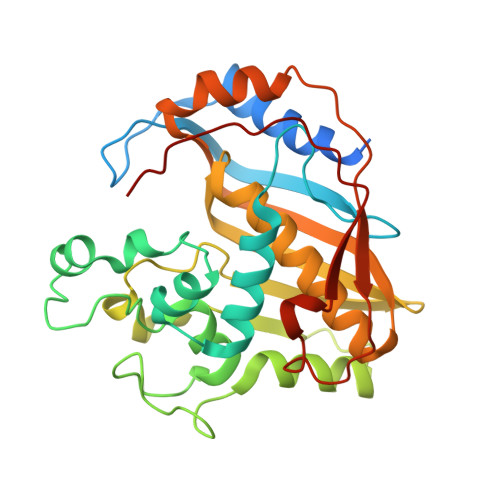Multi-targeted antifolates aimed at avoiding drug resistance form covalent closed inhibitory complexes with human and Escherichia coli thymidylate synthases.
Sayre, P.H., Finer-Moore, J.S., Fritz, T.A., Biermann, D., Gates, S.B., MacKellar, W.C., Patel, V.F., Stroud, R.M.(2001) J Mol Biol 313: 813-829
- PubMed: 11697906
- DOI: https://doi.org/10.1006/jmbi.2001.5074
- Primary Citation of Related Structures:
1JTQ, 1JTU, 1JU6, 1JUJ, 1JUT - PubMed Abstract:
Crystal structures of four pyrrolo(2,3-d)pyrimidine-based antifolate compounds, developed as inhibitors of thymidylate synthase (TS) in a strategy to circumvent drug-resistance, have been determined in complexes with their in vivo target, human thymidylate synthase, and with the structurally best-characterized Escherichia coli enzyme, to resolutions of 2.2-3.0 A. The 2.9 A crystal structure of a complex of human TS with one of the inhibitors, the multi-targeted antifolate LY231514, demonstrates that this compound induces a "closed" enzyme conformation and leads to formation of a covalent bond between enzyme and substrate. This structure is one of the first liganded human TS structures, and its solution was aided by mutation to facilitate crystallization. Structures of three other pyrrolo(2,3-d)pyrimidine-based antifolates in complex with Escherichia coli TS confirm the orientation of this class of inhibitors in the active site. Specific interactions between the polyglutamyl moiety and a positively charged groove on the enzyme surface explain the marked increase in affinity of the pyrrolo(2,3-d)pyrimidine inhibitors once they are polyglutamylated, as mediated in vivo by the cellular enzyme folyl polyglutamate synthetase.
Organizational Affiliation:
Department of Biochemistry and Biophysics, University of California, San Francisco, CA 94143-0448, USA.
















